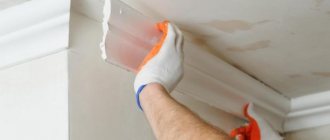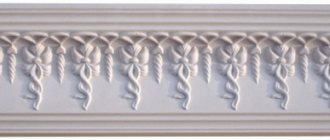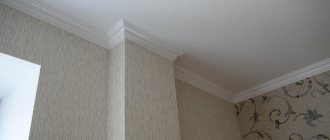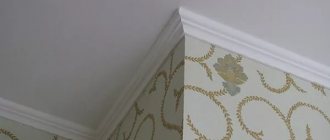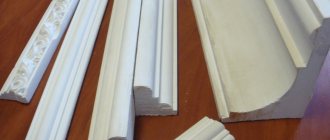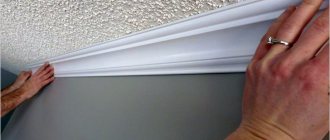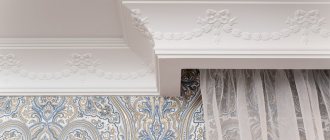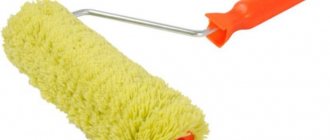Types of skirting boards for ceilings
Materials used for manufacturing.
| Skirting | Description | Photo |
| Polyurethane. | Durable, elastic, bends well and is suitable for decorating even rounded surfaces. It successfully replicates stucco molding, complex ornaments and patterns, and is suitable for painting with any paints. | |
| Wood. | Made from various types of wood. Such ceiling moldings look very expensive and add aristocracy to the interior. | |
| Made from polystyrene foam. | It is characterized by low price and easy installation. The only negative is that it is very fragile and does not bend at all. | |
| PVC (polyvinyl chloride). | Durable, easy to maintain and install. Such models are easy to cut, fit perfectly and can be painted multiple times in different colors. | |
| Polystyrene. | Extruded polystyrene plinth fits perfectly to the wall and ceiling. It washes well and is also easy to paint. | |
| Duropolymer. | Eco-friendly, hard material, resistant to mechanical stress and perfect for rooms with high humidity. | |
| Plaster. | It has an exclusive, aesthetic and rich look. Gypsum models are very reliable, environmentally friendly and fire resistant. |
Skirting to a suspended ceiling: selection features
The most important parameters to pay attention to:
- Lightweight material that will not weigh down the stretch ceiling.
- The surface of the plinth that is adjacent to the wall must be at least 2.5 cm.
- The material should be strong enough, but allow the baguette to bend.
- Using a gypsum baguette requires preliminary preparation.
VIDEO: How to glue a plinth to a suspended ceiling?
Ceiling plinth for suspended ceiling
Do you need skirting boards and how to attach them?
Varieties of skirting board textures
The main types that are classified according to texture parameters:
- Smooth. It has a flat, smooth surface, without indentations, patterns or ornaments. It looks discreet and is great for decorating almost any interior.
- Extruded. It is distinguished by longitudinal recesses with ready-made grooves.
- Injection. It has a convex relief surface and has a granular structure. Such ceiling fillets are an independent decoration.
The photo shows an injection ceiling fillet in a beige shade.
What sizes are there?
There are two main types: wide and narrow. Other tips for choosing the size will be listed below.
Narrow
Size range from 10 to 50 mm. Thin, laconic fillets are suitable for small rooms with low ceilings.
Wide
Allows you to visually smooth out corners and hide imperfections and unevenness of the walls. It has a range from 160 to 350 mm, and is most often used for decorating spacious rooms.
Varieties of fillet shapes
There are several types:
- Straight. The traditional and most common option, which is found in almost any interior.
- Flexible (soft). Such radius baguettes allow you to organize smooth shapes, thereby hiding imperfections, crooked corners and flaws in the ceiling space.
- With cable channel. They have additional internal space in which you can hide wires.
Each of the listed forms carries a certain focus and functionality.
How to glue it securely?
Foam plinth in the interior
There is nothing easier than attaching and painting a foam molding, but it should be mounted on a surface that has already undergone finishing, but has not yet been covered with wallpaper. To complete the task you will need the following set of tools:
- scissors;
- miter box;
- hacksaw for cutting metal;
- the baseboards themselves;
- glue.
It is not recommended to use liquid adhesives. It is better to purchase a special glue based on putty, or make it yourself. In the latter case, according to the instructions, you need to prepare a solution of water and dry gypsum-based putty, to which you add PVA construction glue. For 100 grams of PVA there is 1 liter of prepared putty mixture. The finished substance is applied to the baguette not in continuous strokes, but at intervals of 15 cm, after which the finish is laid in the corner between the ceiling and the wall.
Then you should lightly press down the fillets with your hands until excess glue appears from under them. They will have to seal all the seams and joints. If the surfaces to be treated are uneven, then it is recommended to level the molding along the wall, and mask the gap between the ceiling and the baseboard with the same adhesive putty. All remaining adhesive must be washed off carefully and immediately.
What color are the skirting boards?
Colored fillets change the overall perception of the interior and the room as a whole. In addition, ceiling plinths can be painted independently in any color.
- White.
- Black.
- Gold.
- Brown.
- Beige.
- Grey.
- Chromium.
- Yellow.
- Blue.
- Green.
The photo shows a narrow yellow ceiling fillet in the dining room interior.
To visually expand the space, use baguettes that match the color of the ceiling; to increase the height of the room, use ceiling plinths that match the color of the walls.
How to cover a curtain rod with a ceiling plinth?
Ceiling curtains are an elegant addition to interior design. The apartment looks tasteful if you take care of every detail. Interior design will not be presented correctly when you do not use finishing elements or forget to hide unsightly components of the composition. Proper window design can be the most striking accent in decorating a room. Beautiful curtains will not fully fulfill their decorative role if they are hung sloppily. Use a ceiling plinth that will cover the curtain rod, masking any unsightly details.
The most beautiful interiors are those where individual elements form a harmonious whole. Decorators know that details are always important because they determine how the finished room will look. That is why it is worth taking care of the plinth, which will become the final element of a neat ceiling.
Design options and drawings
A huge variety of decor gives baguettes a more unique look.
- Stucco molding. Always looks expensive and respectable. It brings notes of antiquity and luxury with its appearance and is best combined with classic interiors.
- With inserts. Inserts can be made in various colors, for example white and gold or dark wenge and silver. They are selected in combination with the color of the ceiling or walls.
- Patterns and ornaments. They transform and enliven the ceiling space, deprive it of monotony and set a unified style for the room.
- Ladder. The original cross-section in the form of a ladder creates a stepped ledge, which is quite popular in the design of many interiors.
The photo shows a white wide ceiling molding in the shape of a ladder.
Baguettes with a variety of designs harmonize the decor, give the room a special character and simply look very impressive.
For what types of ceilings can decorative skirting boards be used?
The main types of ceiling coverings to which fillets are applied:
- Stretch ceiling. Such a plinth not only protects and hides cracks and gaps between the walls and ceiling, but is also a rather original element of decorative finishing.
- Suspended ceiling made of plasterboard. For plasterboard two-level or multi-level structures, almost any model will be appropriate. Skirting boards made of polyurethane or polystyrene look especially natural with suspended ceilings.
- Wooden clapboard ceiling. Wooden figured and carved fillets in combination with the identical texture of the ceiling look luxurious and are in perfect harmony with each other.
- PVC panels. Plastic baguettes are better suited here, as they will noticeably highlight and emphasize the design of the entire ceiling.
- Ceiling tiles. Skirting boards will not only complete the overall design, but will also greatly simplify the gluing of ceiling tiles along the edge of the ceiling.
The photo shows a wooden openwork baguette in combination with ceiling lining.
Such models create a single composition on the ceiling and an additional geometric effect.
The photo shows a two-level plasterboard ceiling structure with polystyrene baguettes.
Why do you need a ceiling plinth?
The junction of walls and ceilings does not always look beautiful. Most often, a design without a fillet looks unfinished.
Visual effect
Decorating where the walls and ceiling meet helps create an organic design with a smooth transition. A carefully selected baguette will help visually add height to the room.
Ceiling plinth has many advantages
Hiding communications
Ceiling plinth very often has a practical value - it allows you to hide the laid Internet cable and electrical wiring.
Smoothing out deficiencies in finishing work
When finishing walls and ceilings with wallpaper, plaster or other materials, minor defects may occur. A correctly placed baguette allows you to hide unevenness, as well as flaws in the repairs carried out.
Perfectly smoothes out many imperfections
Photos in the interior of the rooms
Baguettes can become an indispensable and main decoration of any room.
Bathroom
Galleys allow you to beautifully decorate your bathroom, give it the desired appearance or set the style.
Kitchen
Classic simple ceiling models made of polyurethane or polystyrene, which are resistant to high humidity and are easy to clean, would be appropriate here. It is advisable to choose wooden skirting boards for the kitchen without unnecessary patterns and ornaments.
Living room
Baguettes can completely change the interior of the living room, create unusual color and shade combinations and simply decorate the ceiling space.
The photo shows a small room with ash-colored ceiling moldings.
Balcony
To decorate a small balcony, narrow baguettes are suitable, which will visually balance and balance the narrow space.
Children's
Properly selected baseboard colors will allow you to create a harmonious design for the nursery, create smooth color transitions on the ceiling and thereby add additional height to the room.
What do you need to know about the negative aspects?
Foam ceiling plinth
Foam skirting boards mounted on the ceiling are quite fragile products that can be damaged even unintentionally, and this does not require much effort. In addition, such fillets do not have the necessary elasticity, which means they do not adapt to uneven walls or ceilings, form noticeable gaps and crevices, and require careful decorative treatment of joints and corners.
Foam plastic very poorly tolerates the negative influence of chemical and aggressive environments, and therefore requires specific care and special additional treatments. Designers do not recommend using skirting boards made from this material in combination with elite construction and finishing materials, because even after finishing, they look rustic.
A selection of photos of skirting boards in various styles
A wide variety of models and decor allows you to choose an option for a room with any style direction.
Modern
Models of a simple shape with simple lines will look especially organic in this style. Thanks to their versatility and huge selection, they will allow you to create a stylish and modern design.
Classical
Plaster, wooden or polyurethane skirting boards with carved patterns, stucco or gilding are perfect for interiors designed in a classic style.
Loft
This style does not involve intricate decoration. Light fillets with a simple and laconic design are suitable here.
The photo shows a wide white ceiling fillet in a loft-style bedroom.
High tech
Skirting boards with clear lines and shapes, smooth, decorated with lighting, will look unusual and emphasize the futuristic and fantasy interior.
Minimalism
Thin baguettes with a discreet design, made in discreet colors, will harmoniously resonate with the rest of the minimalist decor, and will not attract unnecessary attention.
Scandinavian
White fillets without frills would be especially appropriate here, emphasizing the restraint and coldness of the Nordic style.
The photo shows a white ceiling fillet in a Scandinavian-style living room.
DIY baguette from ceiling plinth
When installing soaring and carved ceilings, plastic baguettes are often used. Plastic building materials are equipped with the following fastening systems - harpoon, cam or wedge.
Before installing plastic ceiling skirting boards, the room perimeter will first be calculated. Then they find the number of baguette profiles that need to be installed on the ceiling.
Comment! At the same time, they take into account that the standard length of a PVC baguette is 2.5 m. They also pay attention to its fastenings and appearance.
During the installation of plastic fillets, perform the following actions:
- The ceiling baguette profile is cut using a special pendulum saw. At the same time, burrs are not allowed to form in the cut areas, which often damage this building material.
- Cut the baseboard angle at 45 degrees.
- Mark the mounting location on the room wall.
- This building material is attached with special dowels.
If the apartment has original decor, then flexible ceiling skirting boards are installed in this room. In this case, this building material is given a round shape and 1 of 3 actions is performed:
- make several cuts on the fillets;
- cut the plinth into several small pieces, then connect its parts together;
- heated with a special construction hairdryer, after deformation, this building material is immersed in cold water.
If certain tools are not available, then polyurethane skirting boards are often installed on the ceiling. After all, such baguette profiles are easily bent and take the desired shape when using hot steam.
Wooden fillets are bent using special steaming. Under the influence of steam, this building material becomes flexible.
After such deformation of the wooden profile is carried out, it is fixed with a special weight. Skirting boards for the ceiling are adjusted according to the same pattern as the floor ones. The main thing here is to cut off the desired angle.
In this case, they often use a special device - a miter box. A file is used to adjust wooden structures.
To avoid staining the wallpaper, polyurethane foam baseboards are painted before the final finishing of the walls. The paint gives the following positive effect:
- masks dents and small scratches;
- makes the plinth durable and presentable in appearance;
- increases the moisture resistance of building materials;
- facilitates future cleaning of the ceiling covering;
- covers corners and joints;
- gives the building material a tint to the walls or ceiling.
Varnish is first applied to wooden baseboards, and then, after putty, oil or other paint is applied. Polyurethane and polystyrene are coated with water-dispersion paints.
When using paints in small containers, painting of such profiles is carried out faster and more efficiently - without the formation of smudges and noticeable stains.
When preparing a baguette for painting, all defects are first removed - small cracks and joints are covered with putty. After complete drying, its irregularities are smoothed out with fine sandpaper. Remove excess composition with a soft cloth.
Illuminated skirting board ideas
The LED strip gives the baguettes an even more original and unique look. This lighting goes well with other lighting fixtures, such as a chandelier, sconce or spotlights.
The photo shows a children's room with a wide ceiling molding decorated with lighting.
How to make corners?
How to make a corner on a ceiling plinth without a miter box
Narrow fillets are cut with ordinary scissors, and with the help of a miter box, the desired cutting angle of 90 degrees is achieved. It is better to divide a wide ceiling plinth made of foam plastic with a hacksaw or a sharp knife, but with smooth rather than jerking movements, otherwise the edges will be torn and begin to crumble.
If you need to cut all the corners at once, make a 3-centimeter allowance on them, and cut off the excess along the straight joints that will be located in the middle of each wall. Don't try to squeeze in a piece of baseboard that's a little larger than you need. It’s better to cut carefully, otherwise creases and cracks will appear along the entire line. And one more thing: the glue should be made as liquid as possible, and lumps should not be allowed to form.
Examples for non-standard ceilings
The functionality of skirting boards makes it possible to use them even in non-standard solutions.
Two-level
On such a ceiling, baguettes look especially beautiful. In addition, they allow you to hide transitions between levels.
The photo shows a two-level ceiling structure, decorated with wide plinths.
Sloping ceiling
Skirting boards for a sloping ceiling on the attic floor in a country house or wooden house must be flexible in order to neatly frame numerous corners in the room.
Rounded
Radius fillets are perfect for rounded ceilings. Such elastic models will easily allow you to decorate semicircular corners without unnecessary problems.
Disadvantages of polystyrene ceiling plinths
Unfortunately, the material also has disadvantages. But they are insignificant, given the advantages of ceiling skirting boards and the nature of their use. The following disadvantages are worth noting:
- melting when exposed to high temperatures. The baseboard material itself is not subject to combustion, but can begin to melt at high temperatures. True, this only happens during a fire, which is a force majeure circumstance;
- exposure of the baseboard to ultraviolet radiation. The material may turn yellow if exposed to sunlight for a long time. The problem is infrequent, so it can be ignored, especially since ceiling plinths after installation are painted with water-based emulsion in the selected color;
- lack of flexibility. Despite the fact that the material is easily subjected to mechanical stress and can be cut, the plinth itself is brittle and cannot always be bent for non-standard ceilings. Therefore, the use of technology is partially limited.
How to choose a ceiling fillet?
A few recommendations for choosing a ceiling molding:
- The fillets should preferably be combined with the color of the ceiling or walls. This way you can create a more cohesive composition.
- Wide ceiling moldings hide defects and imperfections in the room well.
- For low ceilings, you should not use bulky skirting boards, as they visually hide the height of the room.
Table of correspondence between room size and baseboard width
Correct size ratio.
| Room height | Recommended skirting board width |
| Less than 2.5 m | Up to 40 mm |
| 2.5 - 3 m | No wider than 70 mm |
| More than 3 m | 80 mm or more |
| Narrow and high rooms | 70 mm + molding |
Which baguette shape should I choose?
Ready-made skirting boards are usually produced with a length of 200 cm. Their width, depending on the model, can vary in the range of 1-40 cm.
What form of ceiling perimeter design should you choose? The answer to this question should take into account the size of the room and the style of the interior. The luxury of a refined interior will be successfully complemented by a curved plinth made of expensive, high-quality materials. It should be taken into account that the complex texture of the material complicates installation.
If the shape of the baguette is complex, it is necessary to especially carefully design the joints in the corners of the room.
White living room with white baseboard
For simple interiors, the intricate shape of the baseboard will not be organic; in this case, a model with simple lines is preferable. Plus such fillets :
- they are easier to keep clean;
- they are quite versatile.
You can choose different shapes of the plinth
Large room
A spacious room with high ceilings allows the use of wide and even massive fillets, if this is combined with the style of the room. Fillet for a large room should not be too narrow - from 7 cm or more. Figured stucco molding and carving are acceptable . In addition, multi-level friezes can be used. Small and simple ones will look uninteresting.
For rooms stylized in Baroque or Rococo style, fillets can be chosen with stucco. Chic model options that stand out with pomp would be appropriate here.
For a large room you can choose wide baseboards
Advice For expensive, luxurious interiors, it is advisable to use baseboards made of plaster or natural wood, rather than cheaper imitations.
Small room
Low ceilings in a small room are usually decorated with narrow baseboards, without massive elements. For rooms 2.5 m high, fillets up to 4 cm wide are suitable. In larger rooms, you can use fillets 5-6 cm wide.
Choose color when choosing baguettes
The main requirement for this finishing element in small spaces is not to hide the height of the walls.
Narrow corridor
In narrow, dimly lit corridors, it is recommended not to use too thin a baguette. A narrow strip of joint design will create the effect of an even narrower, unbalanced space. To balance the proportions, you can choose a baguette 6 or 7 cm wide.
In a narrow corridor there is a narrow baseboard
Practical advice
In addition to the basic principles for selecting skirting boards, it is necessary to take into account practical recommendations from designers:
- with the help of a wide baguette you can visually smooth out the corners, give completeness, smooth out the corners;
- the wide shape also gives more room for smoothing out defects;
- the greater the width, the easier it is to mask communications.
Wide option smooths out defects well

